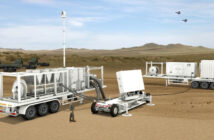By John Knowles
The US Army’s Project Director Sensors-Aerial Intelligence (PD SAI) has issued a Request for Information (RFI) seeking industry responses about current active and passive RF sensor capabilities for “different sized stratospheric platforms” that will serve as a sensing suite in Multi-Domain Operations (MDO).
The Army is developing new airborne sensor capabilities under its Multi-Domain Sensing System (MDSS) family of programs. This includes the High Accuracy Detection and Exploitation System (HADES) airborne ISR program, a manned aircraft that will replace the Army’s fleet of RC-12 Guardrail signals intelligence (SIGINT) aircraft. Another part of MDSS is the High-Altitude Extended-Range Long-Endurance Intelligence Observation System (HELIOS), which will comprise various stratospheric platforms, such as balloons or solar-powered fixed-wing aircraft, fitted with electronic intelligence (ELINT), communications intelligence (ELINT) and radar sensors. By operating at higher altitudes than the Army’s current airborne ISR systems, HADES and HELIOS will support the Army’s deep sensing requirements for MDO.
As part of its HELIOS development program, PD SAI is initially conducting the High-Altitude Platform – Deep Sensing (HAP-DS) experimentation and demonstration effort. The RFI calls for information about currently available (TRL 6 and higher) ELINT, COMINT and radar sensors that can be integrated on a HAPS-DS platform and evaluated in anechoic chamber and/or flight tests in FY2025. Requested sensor information includes overall frequency range, geolocation frequency range and accuracy, signal sets covered by the sensor, pulse and signal density processed, field of view, system architecture standards and payload environmental specifications.
The contracting point of contact is Tianna Woods, 443.861.1919, e-mail [email protected]. RFI responses are due by March 20.





